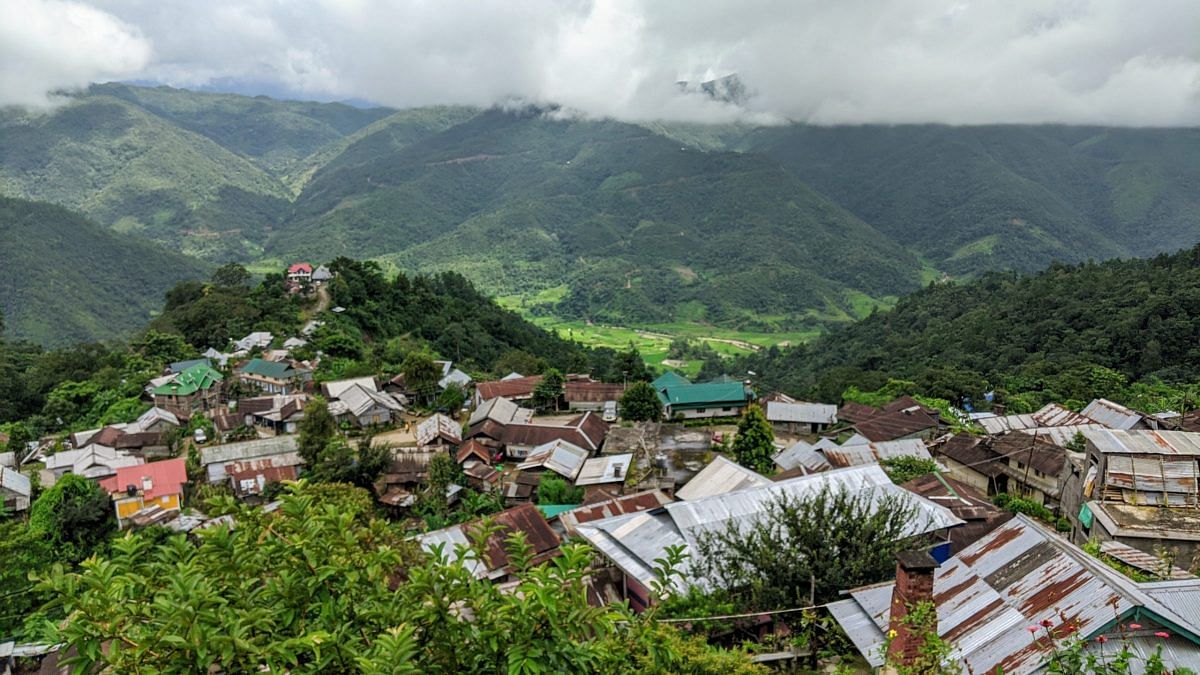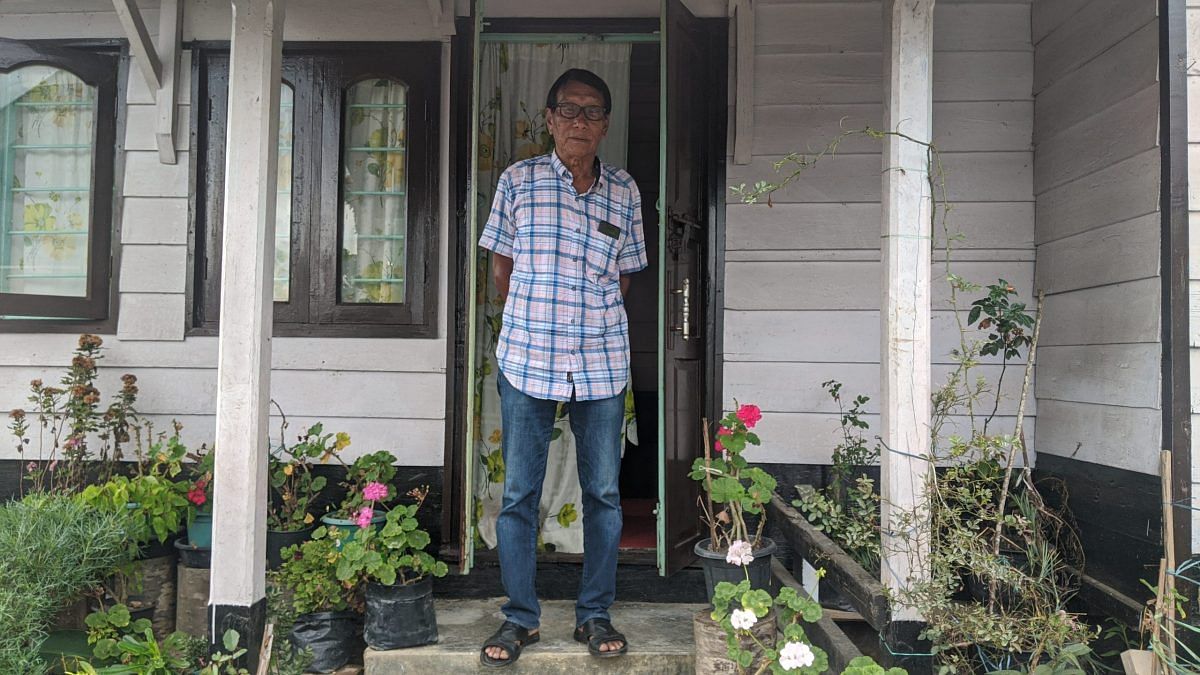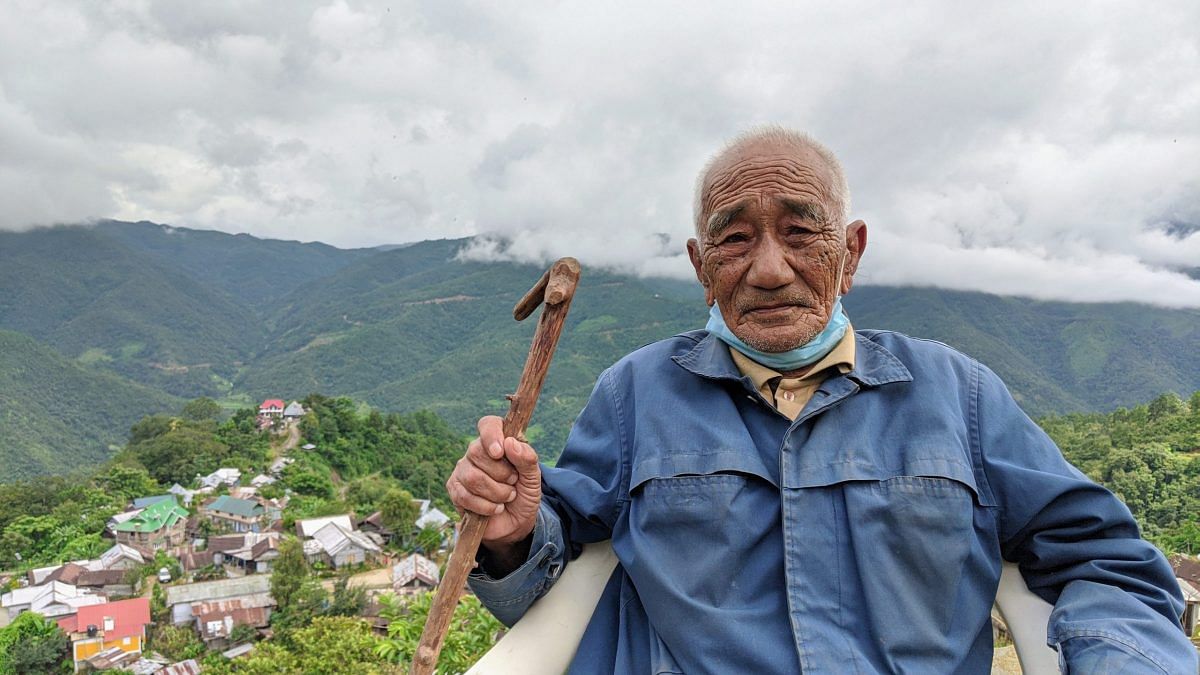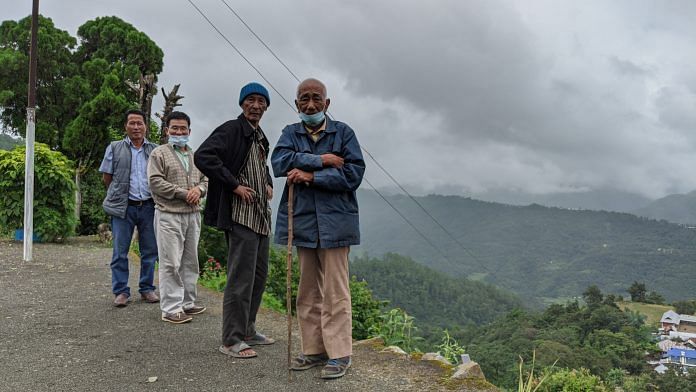Somdal, Ukhrul: It’s hard to imagine Manipur’s Somdal village as having played a crucial role in India’s oldest insurgency.
Nestled in the Western Range of the Tangkhul Naga-dominated Ukhrul district, the quiet and often empty village, from the outside, doesn’t bear many insignias rooting it to the Naga political movement.
Yet, Somdal has “contributed” many a leader to the long-drawn, armed political conflict. The most prominent among them is Thuingaleng Muivah, the current general secretary or Ato Kilonser of the largest Naga armed group — the Nationalist Social Council of Nagaland (Isak-Muivah).
Muivah was born here in 1934 and while he hasn’t set foot in the village since 1963, he still has family here — like his 79-year-old younger brother Vareisui Muivah.
“Currently, the Naga nation is backward. But Nagas are very unique and different from India; our clothing is different, our foods are different, our behaviours are different and we worship differently,” Vareisui Muivah told ThePrint at Th. Muivah’s childhood home in Somdal.
“He (Muivah) carefully and seriously thought to save the Naga nation and because of this he went to join the movement,” the 79-year-old added.
Negotiations between the Modi government and Naga groups have intensified over the past month, with the Thuingaleng Muivah-led NSCN (I-M) at the heart of it. The new round of talks are being held in New Delhi amid the Covid-19 pandemic.
The NSCN (I-M) has been adamant on its demand for a separate flag and constitution, which has emerged as a sticking point. But the NSCN (I-M) also faces a hurdle as the Naga National Political Groups (NNPG) — a group of seven Naga insurgent outfits also holding talks with the central government — seems to be softening its stand and has called for a quicker resolution to the conflict.
Amid the developments, ThePrint travelled to Somdal to meet its residents and Muivah’s family to understand what they feel about the current leg of the more than two-decade long peace process, what it means to the Tangkhul community and the NSCN(I-M)’s role so far.
A history of Somdal’s Tangkhuls
Historically, the Nagas weren’t a composite people and consisted of different tribes and groups who began migrating from China thousands of years ago, eventually making their way into erstwhile India through waves of migrations. Different groups entered the region through varied routes. The Tangkhul Nagas are said to have migrated from China’s Xinjiang province through Myanmar along with five other tribes — Sangtams, Khiamniungans, Yimchungers, Changs and Aos — constituting one group at the time.
The Tangkhuls went on to settle in Ukhrul and Kamjong districts in Manipur and at Layshi township, Somra tract hills, Homalin township and Tamu Township in Myanmar.

“Somdal village might have been established around the 14th century. The people migrated from different directions. Some are from the south, some north and some west, they all settled down here,” Somdal’s Pastor Reverend Aping Khamrang said.
The pastor had earlier pointed out that the church is over 100 years old, and had been built a few years after the arrival of British Missionary William Pettigrew in Ukhrul. One of the earliest Tangkhuls to be proselytised by Pettigrew was R.S. Ruichumhao from Somdal. In 1918, Ruichumhao formed the Naga Club along with British officials, which became the basis of the Naga political movement.
“As I said, I was inspired by the life of Ruichamhao,” Th. Muivah had said in his testimony to Nandita Haksar and Sebastian M. Hongray for their book Kuknalim, Naga Armed Resistance: Testimonies of Leaders, Pastors, Healers and Soldiers.
How it all began
Th. Muivah’s childhood house is a steep climb down from the main centre of Somdal. The left side of the pale pink wooden house opens up to a panoramic view of the village, the surrounding hills and the small valley below, wherein lie paddy fields.
Th. Muivah was born in 1934 to parents who were farmers. “I call my brother ‘Ava Kharar’ which means eldest in the family and he is six years older than me. As a young child, he was very naughty and fierce as well but a very good person,” said 79-year-old Vareisui Muivah.
“When he was young, he liked flying kites. He would also gather all the kids, including us (three brothers), and taught us about what he saw in Imphal, like army training with wooden guns. This was in 1947.”

In Kuknalim, Naga Armed Resistance, Th. Muivah recalled how his father would regularly take him to Imphal— a two-day journey by foot — to work in the paddy fields. It was in Imphal that he also came in contact with the Meteis and “the Indians”.
“The Meities in those days knew how to struggle. The Meitei women were good in small businesses. They were not proud and many Tangkhuls loved them…Now it may be a little bit different,” Th. Muivah had narrated.
He would go on to complete his bachelor’s degree from Shillong’s St Anthony College and his Master’s from Cotton College, Guwahati. It was during this time that Muivah became interested in Communism.
“According to what I heard, while he was studying in Guwahati and Shillong, he extensively read books on Communism,” Vareisui said. “I don’t know what he discovered from that but he said ‘when the Britishers were about to leave India, they granted independence to the Nagas on 14 August. So, because of that I will make Nagas get their freedom back. I am not happy that India is dominant and so I will make sure to gain our freedom back’. And so with this thought he went to join the Naga movement.”
It was at the behest of Rungsung Suisa or Uncle Suisa, as he was known, that Th. Muivah decided to join the Naga National Council (NNC), said Vareisui. A key figure in the movement, Suisa too hailed from Somdal and served as a Congress MP from 1957 to 1962 and later as the assistant to the vice-president of the NNC, which had replaced the Naga Club.
Muivah’s parents had tried hard to dissuade him from joining the NNC. “(But) he said I will serve the nation so don’t stop me from joining. He also said that he won’t be able to come back even when they died because he will be working for the nation,” Vareisui said.
Muivah left Somdal in 1963 — never to return.
Of many splinter groups
For 17 long years, Muivah worked for the NNC. Then came the turning point in 1975 when the Shillong Accord was signed between the government and supposed representatives of the Naga underground groups.
As the agreement had laid down the condition for the Naga groups to accept the supremacy of the Indian Constitution, it was vehemently condemned by Isak Chishi Swu and Muivah. The two leaders along with S.S. Khaplang broke away in 1980 and formed the NSCN. More factions came out of the NSCN over the next few years, giving rise to internecine conflict. The years leading up to 1997 were marked by violence and bloodshed as the insurgents and the counter-insurgent forces collided.
In 1997, a ceasefire agreement was signed between the NSCN(I-M) and the Centre under former Prime Minister H.D. Deve Gowda, marking a watershed moment in the peace negotiations. In 2017, two years after the NSCN(I-M) signed the Framework Agreement in 2015, the seven other factions entered the talks as the NNPGs.
So far, it seems, the NNPGs and the NSCN(I-M) have held opposing views over demands of the separate flag and constitution. In August, tensions reached a fever pitch following a letter by the Governor R.N. Ravi, who is also the interlocutor of the talks, in which he blamed the “grim” law and order situation on the groups who he described as “armed gangs”.
Soon after, the NSCN(I-M) demanded that Ravi be removed as the interlocutor while the NNPGs said that it would derail the talks. In their 18 August press release, NSCN(I-M) stated that the Nagas now have to “choose” between the “the wave of anti-Naga forces in collusion with Ravi-led forces” or “to stay active defending the historical and political rights of the Naga people”.
What Somdal thinks
Some of the villagers of Somdal describe feeling weary at how long the talks have stretched on.
“It’s been a long time, we are tired. it is not like we can go to the peace talk and say something, but we are praying to God,” said 86-year-old Akham Ruivah, a village elder and former member of the NNC.
“We have suffered for a long time. We are praying to God and waiting for a quick solution.”

Akham also expressed his concern over the NSCN(I-M)’s supposed extortion activities, an issue raised by R.N. Ravi as well. “I believe that this talk will be successful but taking money and doing business is not necessary. It will not save the Nagas. There might be those who are taking money and playing with money…I am not happy with that.”
Despite this, the Somdal residents ThePrint spoke to remain hopeful that the NSCN(I-M) would be the one to lead them to a “peaceful resolution” — the unification of all the Naga territories, a separate flag and a separate constitution.
“We are Nagas, there should be a Naga nation. There should be a Naga flag and constitution. Why should we not have it then?…From our Somdal village, there are around 80 Naga national workers (cadres of NSCN(I-M) under the leadership of Muivah. Around 31 people have been killed because of this Naga cause,” pastor Aping Khamrang said.
“Many people and families want to send (to work as Naga national workers) even more now. There has been no exhaustion in our village.”
Tangkhul woes
Beyond the proximity with the NSCN(I-M) leaders, another factor that seems to have driven Tangkhuls to participate in the movement and support the call for unification is the supposed discrimination by the Meiteis, a dominant ethnic group in the state.
“We used to work together with the Meities and Kukis lovingly, but the Meities didn’t care about the Nagas at all. So much development has happened but what are the Nagas getting?” a furious Akham Ruivah alleged.
“We are minorities in Manipur now, and this means that you have [to bear] all the disadvantages in the system,” Hopingson A Shimray, the president of the apex body of Tangkhuls, the Tangkhul Naga Long, said in a telephonic interview.
Shimray also said that the Tangkhuls haven’t had an easy time in the Naga movement either. “In 1991, the Tangkhuls were actually hunted down in Nagaland, because of the factional fight. Many Tangkhuls were killed,” he said. “In spite of this, because the [NSCN (I-M)] leadership is with the Tangkhuls now, we had to have our patience and bear all the misunderstandings.”
Also read: Modi govt could look beyond NSCN (I-M) for peace in Nagaland as new players emerge
- This report has been updated to reflect that Meiteis are an ethnic group. An earlier version of it wrongly identified them as a tribe.




Tangkhuls were never naga. They are related to meeteis .
I want to convey to all the Tangkhuls to never claim yourself as a Naga by blood. You may be known as a Naga by using your surname as a Naga , but you’ll can never be a Naga by Blood. Feel sorry, Don’t try to divulge yourself and act like a Naga when you’re not. Its because of your illiterate and dungheads like you that’s been creating chaos and bias in the society.
You Tangkhuls have a bittersour relationship with the tribes of Nagaland as well as your neighbor Kukis and you talk like a Naga patriot. Without Nagaland do you think solution is possible.? By the way NNPGs are all a breakway factions of NSCN IM led by Tangkhuls. Comon everything about Nagaland is allergic and jealousy to you people and you talk of Naga nationalism. The only true Nagas as far as history could prove in Manipur are Maos and Poumais.
All community has unique history and unique culture identity not for Naga
Please correct a factual mistake both of you wrote that meitei’s are the largest tribe of manipur this is factually wrong, meitei’s are not tribals
Please correct the spelling of some name : 1. Its Kamjong not Kamrong
2. Its Reichumhao not Ruichamhao.